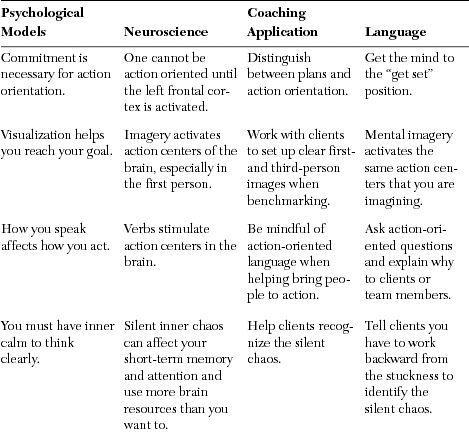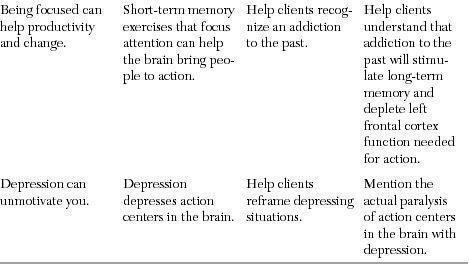Your Brain and Business: The Neuroscience of Great Leaders (24 page)
Read Your Brain and Business: The Neuroscience of Great Leaders Online
Authors: Srinivasan S. Pillay

The application:
Imagery acts as a precursor to action. Note that worry tendencies disrupt the necessary brain regions from activating. When encouraging people to benchmark their goals, it is crucial to ask them to imagine this, preferably in the first person and in the third person. Follow when the imagery breaks down in integrity and continue to practice until it is fluent enough to facilitate the necessary actions. Managers and coaches can tell team members the following: “By imagining what you want, you stimulate the action centers of the brain. Also, if you observe other examples of your goal being achieved, it will feel more real. It is important for this to feel real, and when you do imagine reaching your goal, try to imagine yourself doing it so that you cannot see yourself and instead see things in front of you in addition to observing yourself doing it in the third person.”
Action-Oriented Questions
The concept:
Brain-imaging experiments have shown us that imagining an action stimulates the same brain region involved in the actual performance of that action,
19
although this activation may be at a lower level than occurs when the actual movement or action occurs.
27
Therefore, in coaching, during the education, data collection, and planning phases, when we engage clients in their goals, we are ideally asking them to imagine the course of action they are about to undertake. The pre-action stages of coaching in fact involve observation, planning, imagery, and verbalization. How you verbalize may impact how much you stimulate the left frontal cortex (which is necessary for commitment). For example, if a client asks you to help the company’s sales force improve their selling statistics, you can take several approaches when asking the sales force to observe, plan, imagine, and verbalize. Note the differences within the following two examples:
Example A:
• “What have you been doing so far to make the sales you have made?”
This focuses on the past and is more akin to the approach of certain kinds of therapy. It is far from a decisional commitment and does not promote an action-oriented mindset.
• “What could you do differently to increase the sales you have made?”
This implicitly involves the goal and encourages the client to compare the past and future. The word
differently
asks for more than a contemplation of the past. It promotes an action-oriented mindset.
Example B:
• “If it were that easy to increase sales, you would have already done so. Something is making that difficult. What is that and how can we overcome this in order to reach your goal?”
The question “how” is not identifying the real obstruction. Most people who procrastinate know that they do. Most people who need to make more sales calls know that they do. This question engages the client in a theory that they are already familiar with.
• “If it were that easy to increase sales, you would have already done so. Something is making that difficult. What is that and is it worth overcoming this in order to reach your goal?”
Here, we are involving an assessment. We now know that the client knows what to do, but the client’s brain has not registered
the impact of the new behavior and we are engaging the client in a potential reward. Once the reward is registered, this will promote decisional commitment. People avoid making sales calls because it is boring and because they are sensitive to rejection (and anyone in sales knows that you are rejected more than you are accepted). However, if they realized that every rejection is one step closer to an acceptance, for example, their brains will recode the meaning of rejection.
Even in verbalizing, some interventions are more action oriented and relevant than others. Furthermore, the left anterior midfrontal cortex is critical for processing verbs.
28
(Recall that the left frontal cortex must be stimulated for action orientation or commitment to occur.) In fact, there is a shared verb-related activation of a dorsal premotor and posterior parietal network, pointing to a strong relationship between verb representation and action-oriented (visuo) spatial knowledge.
29
It may also be that verbs are more demanding to process than nouns. Therefore, coaches should be mindful to use action language that this part of the brain can grasp and activate to increase commitment. Here are some examples of progressive action language:
• You are wondering why sales are not increasing.
• Have you launched an investigation into why sales are not increasing?
• So you are not selling enough. Why not?
• What is going to get those products off your shelf?
• What can you do to get those sales up?
• So you literally have to get those packages out the door. What is going to push or pull them out?
There is no right or wrong here. However, language that has no verbs puts the brain at a disadvantage for action. That is why active voice is often better than passive voice. And when you stimulate the brain with an action, it can actually imagine something.
The left inferior frontal gyrus is responsible for speech production. Curiously, this region also shows increased activation during
execution, imagination, imitation, and observation of movements.
30
Thus, language and action are very connected in the brain. As a manager or coach, you use language to bring people to action in their lives. If you can stimulate the language area with its other functions as well (imagination, imitation, or observation), you can stimulate the left frontal cortex and bring a person to action. This implies that you should not settle for the first response when asking a leader to “imagine how things might be if....” Continue to ask “What would that look like?” and other variants of that question. Similarly, if you can show a leader prior success with the same problem, you can activate the leader to greater commitment. Most effectively, leaders can be encouraged to imitate themselves.
The application:
Be mindful to use verbs intelligently and in a way that stimulates the left frontal cortex without burdening it if you are trying to increase commitment to a decision. Also, active voice is more powerful than passive voice, if used intelligently. Coaches can also encourage clients to use verbs when constructing goals or images, and if they know that they want to change in some way, they can continue asking questions until they know the “what” and “when” of their goals and are committed and emotionally engaged in them. Being conscious of verb use is useful learning.
Noise Reduction
The concept:
The DLPFC is part of the left frontal cortex (recall its role in short-term memory). It keeps information online while we are integrating it into long-term memory, if needed. Noise can be obstructive to the integration of information.
31
Internal noise (which activates the ACC) may also affect the quality of information in the DLPFC that is needed for action.
The application:
Internal and external chaos can pull a person in too many directions, even if that chaos is not explicitly expressed. This occurs because action requires some clarity from short-term memory
and, without this clarity, there may not be enough information to get to action.
Stimulate Short-Term Memory
The concept:
The DLPFC is part of the left frontal cortex. One way to stimulate the DLPFC is to give it short-term memory tasks because it is responsible for short-term memory. Therefore, discouraging long and impossible tasks and encouraging team members to focus on the issue at hand may increase their sense of mastery and thus their commitment to their desired goals. For example, if a leader needed to lay off people, he or she might avoid this uncomfortable task. In this case, the leader may become committed to this action by encouraging exploration from different angles. Here managers and leaders can ask each other about some questions and implications:
• “What is the timeframe in which you need to act?”
• “Can you make rehiring part of the long-term plan?”
• “In the next three months, what needs to be achieved?”
This helps to stimulate short-term memory and keeps the brain more committed. If you work in an indefinite time space, the brain cannot become committed to an action. That is why benchmarking is so important.
By stimulating (but not overstimulating) the left DLPFC, we release the brain from habit as well.
32
This addresses the priority of mobilizing employees around “a focused agenda.”
33
The application:
By stimulating short-term memory, managers and coaches can help team members and clients move away from an addiction to the past. In relevant situations, the past may be too vast or overwhelming. Thus, keeping things focused and grounded in recent collections of information may be helpful to an overwhelmed brain.
Benchmarking helps us not just because it defines a goal, but because it gives us some grounding, thereby decreasing anxiety and
allowing for worry to decrease its distracting effects on short-term memory stores.
Address the Emotional Elements Affecting the DLPFC
The concept:
When magnetic stimulation was applied to the left frontal cortex (DLPFC), it was found that depression was alleviated.
34
This implies that when this brain region is stimulated, depression appears to abate. To help diminish a leader’s depression, coaches can lessen the burden by recognizing that transparency and interaction with the firm removes the pressure of secrecy and helps in involving others in the decision.
• “How many people do you need to lay off?”
• “Is it people you need to lay off or money that you need to generate within the company?”
• “How else can this money be generated?”
• “Do you have to lay off ten people or can you lay off five and cut the salaries of other people?”
• “What specifically are you concerned about? Being disliked? Hurting people?”
• “How can you help people understand the need for layoffs?”
• “Can you share this dilemma? Can you send a memo stating that layoffs are possible and asking people to suggest innovative alternatives?”
As you can see, the less the leader feels intimidated by his or her own choices, the more likely it is that he or she will become committed to that action. A leader does not have to feel isolated in making a choice. Involving others is a show of commitment to doing as much as can be done for people. The leader will become less depressed if he or she can see him- or herself not as the all-powerful one but as someone who must coordinate and represent the actions of the followers.
The application:
When leaders are depressed, this depresses the action-orientation centers in the brain. Although you may not be qualified to treat depression, you can use reframing methods to explore how a static frame has entrapped the client and has led to this decrease in action orientation. You can tell leaders or other team members the following: “I think that we should look at this from different perspectives, and focus on potential solutions. In these kinds of situations, you probably feel trapped because you don’t want to hurt people, but you see no other options. Let’s help bring you to action by removing the paralyzing effect your mood is having on your action-orientation brain centers.” The table below summarizes how the brain science underlying action orientation can be applied to the business environment
Table 5.3. Summary and Overview of Concepts on Commitment and Action Orientation

